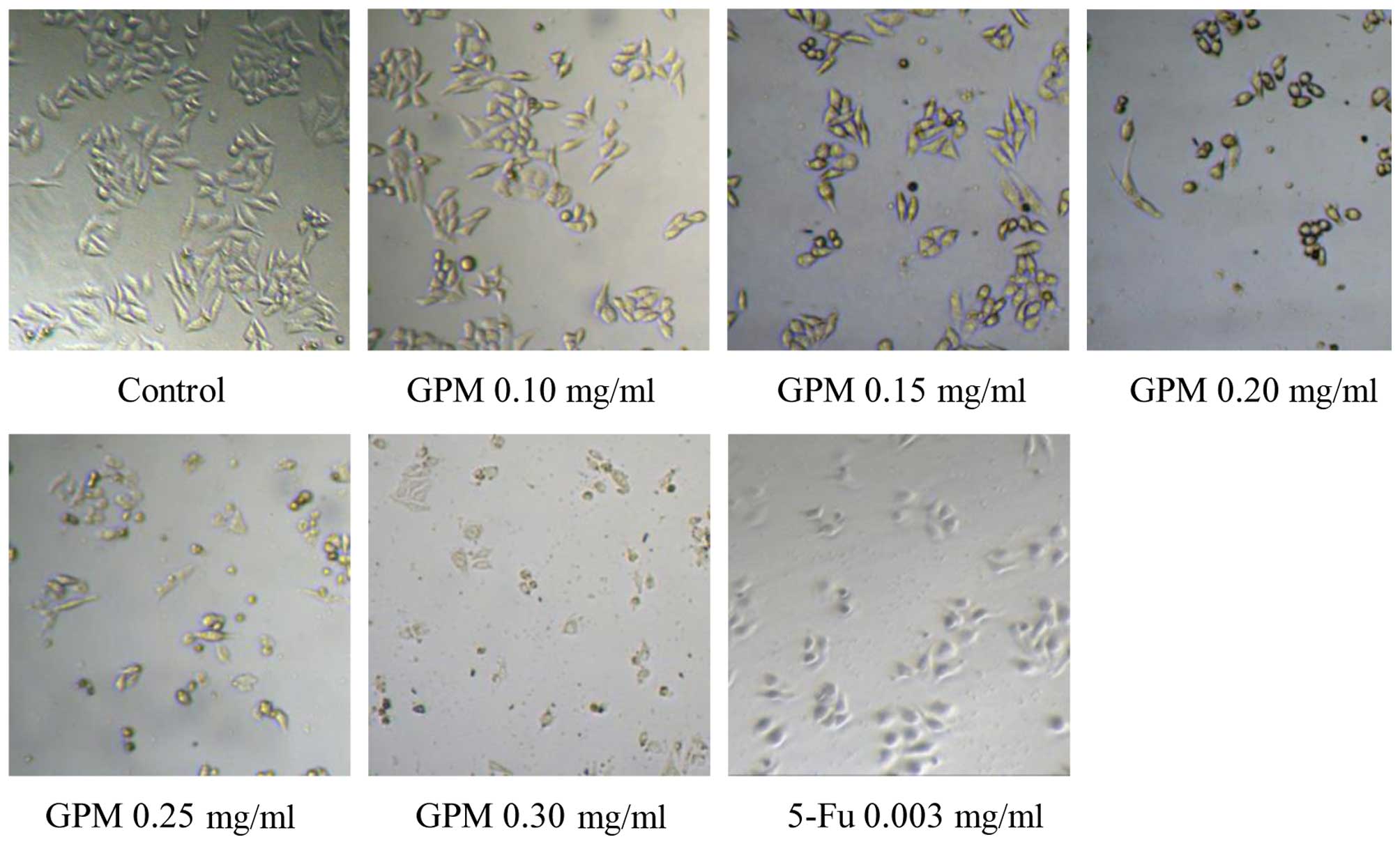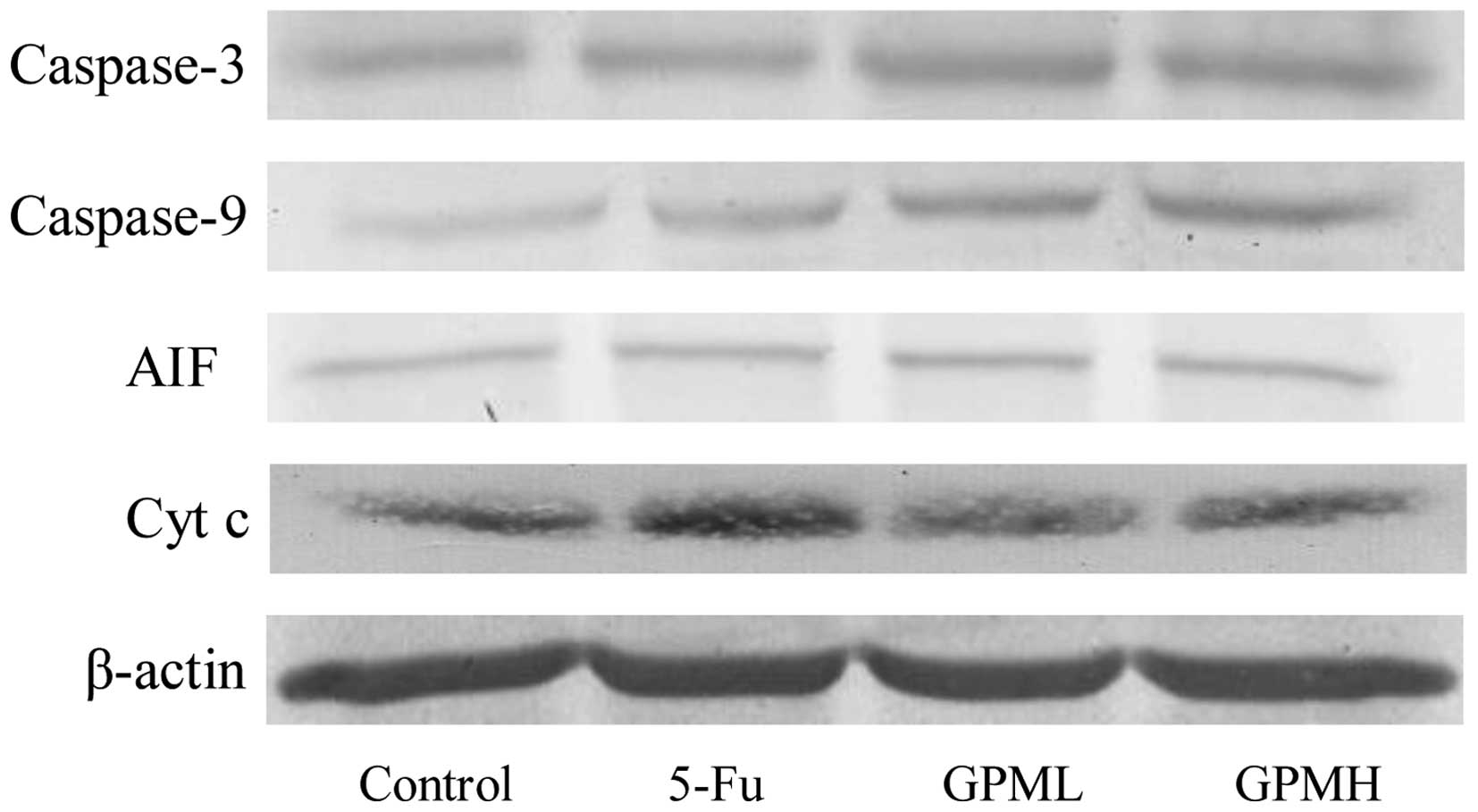|
1
|
Abrams P and Marsh JW: Current approach to
hepatocellular carcinoma. Surg Clin North Am. 90:803–816. 2010.
View Article : Google Scholar : PubMed/NCBI
|
|
2
|
But DY, Lai CL and Yuen MF: Natural
history of hepatitis-related hepatocellular carcinoma. World J
Gastroenterol. 14:1652–1656. 2008. View Article : Google Scholar : PubMed/NCBI
|
|
3
|
Faivre S, Bouattour M and Raymond E: Novel
molecular therapies in hepatocellular carcinoma. Liver Int.
31(Suppl 1): 151–160. 2011. View Article : Google Scholar : PubMed/NCBI
|
|
4
|
Kang TH, Bang JY, Kim MH, Kang IC, Kim HM
and Jeong HJ: Atractylenolide III, a sesquiterpenoid, induces
apoptosis in human lung carcinoma A549 cells via
mitochondria-mediated death pathway. Food Chem Toxicol. 49:514–519.
2011. View Article : Google Scholar : PubMed/NCBI
|
|
5
|
Liao N, Ao M, Zhang P and Yu L: Extracts
of Lycoris aurea induce apoptosis in murine sarcoma S180 cells.
Molecules. 17:3723–3735. 2012. View Article : Google Scholar : PubMed/NCBI
|
|
6
|
Wang YX, Gu XX, Geng D, Sun HY, Wang CM,
Jiang GX, Hou XN and Ma CH: Differentiation of bel-7402 human
hepatocarcinoma cells induced by aqueous extracts of fresh gecko
(AG) and its anti-tumor activity in vivo. J Ethnopharmacol.
155:1583–1588. 2014. View Article : Google Scholar : PubMed/NCBI
|
|
7
|
Song P: Wang XM and Xie S: Experimental
study on mechanisms of lyophilized powder of fresh gekko Chinenis
in inhibiting H22 hepatocarcinoma angiogenesis. Zhongguo Zhong Xi
Yi Jie He Za Zhi. 26:58–62. 2006.(In Chinese). PubMed/NCBI
|
|
8
|
Yang JX and Wang XM: Progress study and
research on treating tumor of Gecko. Chinese Journal of Digestion.
14:2428–2431. 2006.
|
|
9
|
Wu BD: Treatment of 105 cases of esophagus
tumor by compound recipe of Gecko. Zhongguo Zhongxiyi Jiehe Za Zhi.
19:5021999.(In Chinese).
|
|
10
|
Song Y, Wang JG, Li RF, Li Y, Cui ZC, Duan
LX and Lu F: Gecko crude peptides induce apoptosis in human liver
carcinoma cells in vitro and exert antitumor activity in a mouse
ascites H22 xenograft model. J Biomed Biotechnol. 2012:7435732012.
View Article : Google Scholar : PubMed/NCBI
|
|
11
|
Cui CC: Research of antitumor effect of
Gecko ethanol extract II. Henan University of Science and
Technology. 2013.(In Chinese).
|
|
12
|
Jiang CP, Ding H, Shi DH, Wang YR, Li EG
and Wu JH: Pro-apoptotic effects of tectorigenin on human
hepatocellular carcinoma HepG2 cells. World J Gastroenterol.
18:1753–1764. 2012. View Article : Google Scholar : PubMed/NCBI
|
|
13
|
Olefson S and Moss SF: Obesity and related
risk factors in gastric cardia adenocarcinoma. Gastric Cancer.
18:23–32. 2015. View Article : Google Scholar : PubMed/NCBI
|
|
14
|
Wang N, Tan HY, Li L, Yuen MF and Feng Y:
Berberine and Coptidis Rhizoma as potential anticancer
agents: Recent updates and future perspectives. J Ethnopharmacol.
176:35–48. 2015. View Article : Google Scholar : PubMed/NCBI
|
|
15
|
Costantino VV, Lobos-Gonzalez L, Ibañez J,
Fernandez D, Cuello-Carrión FD, Valenzuela MA, Barbieri MA, Semino
SN, Jahn GA, Quest AF and Lopez LA: Dehydroleucodine inhibits tumor
growth in a preclinical melanoma model by inducing cell cycle
arrest, senescence and apoptosis. Cancer Lett. 372:10–23. 2016.
View Article : Google Scholar : PubMed/NCBI
|
|
16
|
Xu XL, Wang JG, Li RF, Li SP, Qiu XJ and
Duan LX: Inhibitory effect of Gecko peptides mixture on growth of
human esophageal squamous carcinoma cell line EC109 cells. Zhongguo
Lin Chuang Yao Li Xue Za Zhi. 29:602–604. 2013.
|
|
17
|
Song Y, Wang JG, Cui CC, Qian X, Li RF,
Duan LX, Liu L and Xi SM: Apoptotic mechanism of gecko crude
peptides on human liver carcinoma cell line HepG2. Zhong Yao Cai.
35:863–866. 2012.(In Chinese). PubMed/NCBI
|
|
18
|
Lowe SW and Lin AW: Apoptosis in cancer.
Carcinogenesis. 21:485–495. 2000. View Article : Google Scholar : PubMed/NCBI
|
|
19
|
Bhatia D, Mandal A, Nevo E and Bishayee A:
Apoptosis-inducing effects of extracts from desert plants in HepG2
human hepatocarcinoma cells. Asian Pac J Trop Biomed. 5:87–92.
2015. View Article : Google Scholar
|
|
20
|
Li CJ, Huang SY, Wu MY, Chen YC, Tsang SF,
Chyuan JH and Hsu HY: Induction of apoptosis by ethanolic extract
of Corchorus olitorius leaf in human hepatocellular
carcinoma (HepG2) cells via a mitochondria-dependent pathway.
Molecules. 17:9348–9360. 2012. View Article : Google Scholar : PubMed/NCBI
|
|
21
|
Yang B, Wang YQ, Cheng RB, Chen JL, Chen
J, Jia LT and Zhang RS: Induction of cytotoxicity and apoptosis in
human gastric cancer cell SGC-7901 by isovaltrate acetoxyhydrin
isolated from Patrinia heterophylla bunge involves a mitochondrial
pathway and G2/M phase cell cycle arrest. Asian Pac J Cancer Prev.
14:6481–6486. 2013. View Article : Google Scholar : PubMed/NCBI
|
|
22
|
Kim TM, Shin SK, Kim TW, Youm SY, Kim DJ
and Ahn B: Elm tree bark extract inhibits HepG2 hepatic cancer cell
growth via pro-apoptotic activity. J Vet Sci. 13:7–13. 2012.
View Article : Google Scholar : PubMed/NCBI
|
|
23
|
Nho KJ, Chun JM and Kim HK: Ethanol
Extract of Dianthus chinensis L. induces apoptosis in human
hepatocellular carcinoma HepG2 cells in vitro. Evid Based
Complement Alternat Med. 2012:5735272012. View Article : Google Scholar : PubMed/NCBI
|
|
24
|
Li L, Chen GG, Lu YN, Liu Y, Wu KF, Gong
XL, Gou ZP, Li MY and Liang NC:
Ent-11α-Hydroxy-15-oxo-kaur-16-en-19-oic-acid inhibits growth of
human lung cancer A549 cells by arresting cell cycle and triggering
apoptosis. Chin J Cancer Res. 24:109–115. 2012. View Article : Google Scholar : PubMed/NCBI
|
|
25
|
Cao MR, Li Q, Liu ZL, Liu HH, Wang W, Liao
XL, Pan YL and Jiang JW: Harmine induces apoptosis in HepG2 cells
via mitochondrial signaling pathway. Hepatobiliary Pancreat Dis
Int. 10:599–604. 2011. View Article : Google Scholar : PubMed/NCBI
|
|
26
|
Susin SA, Lorenzo HK, Zamzami N, Marzo I,
Snow BE, Brothers GM, Mangion J, Jacotot E, Costantini P, Loeffler
M, et al: Molecular characterization of mitochondrial
apoptosis-inducing factor. Nature. 397:441–446. 1999. View Article : Google Scholar : PubMed/NCBI
|
|
27
|
Liu X, Kim CN, Yang J, Jemmerson R and
Wang X: Induction of apoptotic program in cell-free extracts:
Requirement for dATP and cytochrome c. Cell. 86:147–157. 1996.
View Article : Google Scholar : PubMed/NCBI
|
|
28
|
Norberg E, Orrenius S and Zhivotovsky B:
Mitochondrial regulation of cell death: Processing of
apoptosis-inducing factor (AIF). Biochem Biophys Res Commun.
396:95–100. 2010. View Article : Google Scholar : PubMed/NCBI
|
|
29
|
Chandra D, Liu JW and Tang DG: Early
mitochondrial activation and cytochrome c up-regulation during
apoptosis. J Biol Chem. 277:50842–50854. 2002. View Article : Google Scholar : PubMed/NCBI
|
|
30
|
Zhang P, Xu Y, Li L, Jiang Q, Wang M and
Jin L: In vitro protective effects of pyrroloquinoline quinone on
methylmercury-induced neurotoxicity. Environ Toxicol Pharmacol.
27:103–110. 2009. View Article : Google Scholar : PubMed/NCBI
|
|
31
|
Li LK, Rola AS, Kaid FA, Ali AM and Alabsi
AM: Goniothalamin induces cell cycle arrest and apoptosis in H400
human oral squamous cell carcinoma: A caspase-dependent
mitochondrial-mediated pathway with downregulation of NF-κβ. Arch
Oral Biol. 64:28–38. 2016. View Article : Google Scholar : PubMed/NCBI
|
|
32
|
Li Y, Hu J, Huang H and He Y: Effect of
Jinlong capsule on proliferation and apoptosis of human pancreatic
cancer cells BxPC-3. J Tradit Chin Med. 33:205–210. 2013.
View Article : Google Scholar : PubMed/NCBI
|
|
33
|
Du RH, Cui JT, Wang T, Zhang AH and Tan
RX: Trichothecin induces apoptosis of HepG2 cells via caspase-9
mediated activation of the mitochondrial death pathway. Toxicon.
59:143–150. 2012. View Article : Google Scholar : PubMed/NCBI
|
|
34
|
Kang MH and Reynolds CP: Bcl-2 Inhibitors:
targeting mitochondrial apoptotic pathways in cancer therapy. Clin
Cancer Res. 15:1126–1132. 2009. View Article : Google Scholar : PubMed/NCBI
|
|
35
|
Jin Q, Nan JX and Lian LH: antitumor
activity of leaves from potentilla discolor on human hepatocellular
carcinoma cell line HepG-2. Chin J Nat Med. 9:61–64. 2011.
|















